I’m pretty sure I always almost agree with you, but I’m never sure I actually know what the heck you said.lulz, I'll take that over "Never-Slide-In-Garm-In" and the gatekeeping guild remoras that feed off that sclerosis. Every day of the week and twice on AOG Sunday.
I think auto retrofit is the future of rec aviation for us sub-100K poors in this hobby anymore. This level of the aviation space will never be safe, but it's not the technical/physics moonshot being speciously characterized as [in order to justify the exclusionary expense], either.
You are using an out of date browser. It may not display this or other websites correctly.
You should upgrade or use an alternative browser.
You should upgrade or use an alternative browser.
How can certified avionics be so crappy?
- Thread starter MountainDude
- Start date
Ed Haywood
En-Route
The AV-30 issues I've seen reported were about DG precession, which has been rectified with the availability of an external magnetometer.yet there are so many reports of failures, some being pretty systematic (like AV-30).
I've tested my AV-30 in AI mode by flying a sportsman aerobatic sequence and it held orientation throughout.
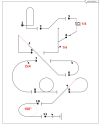
AV8R_87
Line Up and Wait
Notice I didn't specifically say TSO. One of the first things you do when you install equipment is a hazard analysis. If the failure can crash the aircraft or kill people, you need level A qualifications and/or redundancy. A TSO means the equipment meets whatever qualifications are specified in it, but at the end of the day, you need qualifications for the equipment to meet or exceed the DAL associated with the failure category. And you need them at the installation level.We’ve been installing non-TSO equipment in TC aircraft for years. The standards you mention along with a TSO and other similar standards only apply to the production of the equipment(Part 21).
For example, several years ago the non-TSO G3X was certified for installation in TC aircraft via an AML-STC which included the abilities to operate IFR and couple to an autopilot if so equipped. So hardly does one need luck to get these installation approvals
From the install manual:
Standby attitude, airspeed, and altitude instruments are required if a G3X display unit is installed as the primary flight display (PFD) in IFR installations. The standby instruments may be a Garmin G5, GI 275, or existing pneumatic instruments. IFR installations which include Copilot displays must use the G5.
Why? Because that's their hazard mitigation strategy. You must have other qualified equipment in there to back it up if it fails. And that's on top of all the additional documentation that they had to create and show the FAA, which you, an independent installer, would never have access to. If you look in the install manual for the G3x, you'll find DO-160 references, for example. Even if not fully qualified, those boxes have at least partial qualifications. The software is most likely developed using DO-178 methods, even if they didn't go for software certification. All that information was most likely submitted to the FAA in order for them to get thst STC.
Now, do you think "Bell206 Enterprises" could do that, on their own? Just take the G3x boxes with no Garmin support or technical information, no additional test data and software traceability, no back-up instrumentation, and get an STC for that install?
And notice how I did use TSO. You do realize that a TSO is not an installation approval but only an authorization to design and produce a part?Notice I didn't specifically say TSO. One of the first things you do when you install equipment is a hazard analysis.
As to installing that part, the first thing an installer would do is to determine if the installation is a major or minor alteration. That determination is what sets the requirements for any further analysis or supporting data for that particular installation.
I merely replied to your comment that it would take “luck” to get equipment certified for IFR without a "DO-178C Level B" sticker on the box. Garmin did it. Whether it requires standby instruments to use the G3X for IFR is immaterial. The certified IFR functionality is there.Why? Because that's their hazard mitigation strategy. You must have other qualified equipment in there to back it up if it fails.
If you want standalone IFR capability, then buy at that upper price range. No different than people who buy a JPI 830 vs a 930 for the price/functionality even though they must retain the OEM indicators.
Sure. But whether it would be feasible to drop the standby instrument requirement Garmin has, I wouldn’t know. However, if you believe just because someone else has obtained an FAA installation approval, that it is impossible for other person to get a similar approval for the same equipment you would be greatly mistaken.Now, do you think "Bell206 Enterprises" could do that, on their own?
AV8R_87
Line Up and Wait
It's not. A TSO Authorization Letter is what does that. The actual Technical Standards Order only defines what it takes to get there.You do realize that a TSO is not an installation approval but only an authorization to design and produce a part?
14 CFR 21.93(a)As to installing that part, the first thing an installer would do is to determine if the installation is a major or minor alteration.
A “minor change” is one that has no appreciable effect on the weight, balance, structural strength, reliability, operational characteristics, or other characteristics affecting the airworthiness of the product.
How do you determine the bold part is not affected? Oh yes, you look at how the new stuff you put in can fail and what it will take with it in the process.
Stand by for the breaking news on Avweb and other websites, announcing my AML STC approving the iPad for IFR operations. It will install a mount and power supply, a data converter, and will require the presence of a certified attitude indicator, directional gyro, airspeed indicator, sensitive altimeter, turn coordinator, GPS navigator meeting the requirements of TSO-C146 and a course deviation indicator installed in the pilot's primary field of view. But hey, I have STCd the iPad for IFR use, right? Next, I'll show you how to make nail soup.The certified IFR functionality is there.
You do have a way of twisting words...However, if you believe just because someone else has obtained an FAA installation approval, that it is impossible for other person to get a similar approval for the same equipment you would be greatly mistaken.
If you have a piece of equipment that has the right qualifications for the installation, it is much easier for any outfit to get an STC to install it. If that qualification data is not available, the equipment manufacturer can use alternate methods to show compliance, based on proprietary internal data that they can share with the FAA. They will almost never share that data with you, and that will make your life a lot more difficult. It's not more difficult for you to get an STC because they have already done it, it's a case of them having proprietary supporting data that they will not share with anyone else.
So are you now stating that a TSOA letter provides installation approval for a TSO article?A TSO Authorization Letter is what does that.
You are still stuck in Part 21. A major or minor change to type design (Part 21) is not the same as a major or minor alteration (Part 43). Plenty of guidance on this.14 CFR 21.93(a)
A “minor change” is one that has no appreciable effect on the weight, balance, structural strength, reliability, operational characteristics, or other characteristics affecting the airworthiness of the product.
How do you determine the bold part is not affected? Oh yes, you look at how the new stuff you put in can fail and what it will take with it in the process.
What guides my decisions in how a new part installation will affect the aircraft will depend on how I classify the part installation: minor alteration, major alteration, or major change to type design. The items you listed above are for making the classification determination and not for making a failure review as you imply.
Stand by for the breaking news on Avweb and other websites,
So you are implying Garmin and FAA are full of BS and the G3X is not certified as a primary IFR navigation device even though the approved documentation permits it?The certified IFR functionality is there.
You jest but even though the FAA’s current stance on using iPads as a primary navigation device is “no, but F-no,” my guess in about 5 years there will be an STC for their use in this manner, especially given the advancements in Class 2 EFBs using iPads. Be careful what you wish for.I have STCd the iPad for IFR use, right?
No twisting, just following your narrative. But just because Garmin has an STC, that doesn't make it any easier for me to obtain one. I would still need to develop my own proprietary supporting data for my elected FAA approval process which may not be an STC in all cases.You do have a way of twisting words...
If you have a piece of equipment that has the right qualifications for the installation, it is much easier for any outfit to get an STC to install it.
FYI: keep in mind, STCs can have a dual purpose. First they can be used to approve a major change to type design for a single Type Certificate. Or, an STC can also be used to develop base-line design data approvals across many different TCs... even if the part installation is considered a minor alteration.
Ed Haywood
En-Route
Ooh, question about that. It is sometimes stated that an STC is always a major alteration requiring a 337. But, as you have educated me, the installer determines whether an alteration is major or minor, based on the definitions in the FAR and amplifications in various AC's, etc.Or, an STC can also be used to develop base-line design data approvals across many different TCs... even if the part installation is considered a minor alteration.
So if an STC with AML is intended to be a minor alteration in most circumstances, is that stated anywhere in the STC documentation?
As a for instance, let's take the JPI EDM 830. It is not approved for primary indication, but comes with STC's for the temperature indicator and fuel flow transducer as advisory. Adding a secondary indicator redundant to primary gauges is pretty obviously a minor alteration in most situations, and just about any idiot can install using acceptable methods and practices ... even me!
But I have seen it argued that the STC makes it major. Is there anything in writing to refute that?
The argument is usually due to the lack of knowledge of the STC system vs Part 43 requirements. But if you’re looking for an FAA statement that says all STCs are not major alterations you won’t find one. At least I haven’t found it. As I've noted there are generally 2 separate reasons you see STCs: provide approved data for a major change to type design or, to streamline the design approval process across multiple TCs, or to do both. Here's one reference on the streamline side:But I have seen it argued that the STC makes it major. Is there anything in writing to refute that?
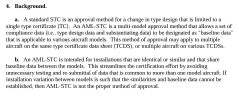
Another scenario is when a single STC installation may be a major alteration on one model aircraft and a minor alteration on another model aircraft. For example, Rosen Sunvisor systems fall under this scenario.
Then you have some articles like Concorde batteries, that will provide you with STC, PMA, and TSO approvals all for the same battery. So which one would you use?
Sometimes. Depends on the STC holder. It can be noted on the STC document itself or included within the data package. Two examples below. Both McFarlane as they are easy to find. But there are others.So if an STC with AML is intended to be a minor alteration in most circumstances, is that stated anywhere in the STC documentation?
Prop Guard STC
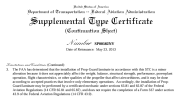
Flap Roller Kit
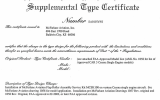
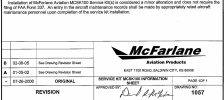
Last edited:
Ed Haywood
En-Route
Whichever is the path of least resistance for my particular installation. I lean towards PMA when available. Quick guesses on this particular question:Then you have some articles like Concorde batteries, that will provide you with STC, PMA, and TSO approvals all for the same battery. So which one would you use?
Replacing a Concorde with an identical Concorde - PMA
Replacing a Gill series 25 with a Concorde series 25 and my plane is not on the PMA list - TSO
Replacing a lithium battery with a Concorde and mods to battery box required - STC
At least that is my take based on my very limited experience at chasing down such things for my IA. My Decathlon log entry from my recent restoration was 5 pages long. It had about 5 STC, 5 TSO, 10 PMA, and dozens of TC part numbers and drawing numbers. Also generated several 337's, most notably for the recover, which is a major repair, but not a major alteration because I used the TC covering specification.
A really complicated topic here.My understanding was that certified equipment is so expensive because it has to be super robust.
Then you read about G5s and GPS175s not working and Garmin not being helpful, chronic issues with current BK devices they can't figure out how to fix, and AV-30 from uAvionix having lots of issues. Macs and iPhones are more complicated, yet they simply work, even though they are not certified. Why cant avionics work as robustly as iDevices, or Dell desktops? Very frustrating.
I have worked in consumer software, 99.9999 safety stuff, and now automotive OEM stuff. There are a lot of differences.
In safety critical software and systems, the key word at times is "mitigation". Instead of being absolutely sure it wouldn't fail, you evaluate the failure modes and make a case for why the possible failure modes are acceptable. And you get that signed off etc etc. Already there's something there that maybe people don't expect. The goal from the start was never to be totally reliable but to not make you think it is so that in the case something does goes wrong the error/failure is known and can be mitigated by using a backup or by actions of the operator. In my previous roles we just stop the train most of the time when something goes wrong. Not what the customer wants for sure but we don't have to wear the train touching stuff cause we try to keep going with a failure. This predisposition for going to the "safe" state can seem to the customer to be quite stupid and exasperating. And while we have human factors analysis and paper work, no one would ever call the user interfaces nice or polished. A lot of times the interfaces are simply functional and can be quite complicated and annoying for no good reason then we didn't want to spent the time and cost to make it better. We'd rather drop hours of training and reams of documentation on the train system operators
Automotive is similar when it comes to safety, often the goal is to let the driver know so they can stop the car or don't drive it. There is of course the other side of customer satisfaction and repeat revenue. As such there's more emphasis on usability, reliability and user experience. A lot more effort's spent on touch and feel and smoothness and fixing things that can annoy the customer.
Consumer software which is closest to the iPhone and actually one of my jobs actually contributed to the Macs, is another ball game. Testing is way less strict compared to safety critical. Often I see no written test plans and when they are written I always have to stop myself asking for more details as it is really not needed.
What is true for automotive and consumer software is that they actually, to me, less complex than safety critical stuff by far. I don't think it is fair to compare the iPhone to your G5 or GPS175 or whatever else in a plane. iPhones and other more "pure" software implementation lives in highly regular environment for the most part. The part of your phone that comes closest to the more wild west environment that safety critical stuff does, is your maps or nav apps. And those fail way more. Your typical interaction on a phone are completely controlled by the interface. There are only buttons to do certain things. iPhones in particular is very locked down. There's a way to do things (like why don't you get folders for your images?) and that's it usually. Going to a device that sit in a plane, has to deal with the real world and real users that can do a lot of unexpected things with many different installation in tin cans that are older than their owners? That's a lot harder. It's just a simple matter of possible permutations for real world vs virtual locked down world.
So my answer to your question is basically: iPhones are actually less complex in terms of use cases, and there's more money spent in non safety for user experience and reliability due to repeated revenue opportunities. For things that are safety often the expectation is they'll stay in service for decades, cost a lot up front and repeated customers are hit and miss.
AV8R_87
Line Up and Wait
And notice how I did use TSO. You do realize that a TSO is not an installation approval but only an authorization to design and produce a part?
It's not. A TSO Authorization Letter is what does that. The actual Technical Standards Order only defines what it takes to get there.
You claimed the TSO is the authorization to produce the part. I told you that is not the case, the Authorization Letter does, after you comply with the requirements in the TSO. I doubt you're not able to follow the conversation, you're just actively stirring the shpot. What' next, play the stupid game of "Answer yes or no, have you stopped beating your wife?"?So are you now stating that a TSOA letter provides installation approval for a TSO article?
Fine, have it your way.You are still stuck in Part 21. A major or minor change to type design (Part 21) is not the same as a major or minor alteration (Part 43). Plenty of guidance on this.
14 CFR 1.1
Major alteration means an alteration not listed in the aircraft, aircraft engine, or propeller specifications—
(1) That might appreciably affect weight, balance, structural strength, performance, powerplant operation, flight characteristics, or other qualities affecting airworthiness; or
(2) That is not done according to accepted practices or cannot be done by elementary operations.
So, how are you going to prove that your G3x install (or any other piece of uncertified avionics) does not affect the airworthiness of the aircraft you're installing it in? Also, notice how similar the language is to the one in 21.93. I wonder why...
I'm not allowed to remove any of the primary flight instruments this thing claims to replace. Seems like a good deal of creative marketing to me. At that point all you have is a non-essential, not required piece of equipment. Might as well get it approved and installed under NORSEE rules, but it's fancier to claim you have an STC for it. Look at the Aspen EFD 1000 - that is a PRIMARY attitude indicator replacement. No requirement for a back-up attitude indicator. Everything else is eye candy and you have to keep the existing instruments, but they openly state that.So you are implying Garmin and FAA are full of BS and the G3X is not certified as a primary IFR navigation device even though the approved documentation permits it?
When they get an STC to install this standalone (it's ok to have two of them for redundancy, but no other instruments), we can congratulate them for an amazing accomplishment.
I'm perfectly happy with using uncertified equipment with a proven track record to improve situational awareness and safety of flight. I will do all the due diligence to make sure said piece of equipment doesn't have an adverse effect on the airworthiness of the aircraft, which will support the "minor alteration" entry in the logbook.You jest but even though the FAA’s current stance on using iPads as a primary navigation device is “no, but F-no,” my guess in about 5 years there will be an STC for their use in this manner, especially given the advancements in Class 2 EFBs using iPads. Be careful what you wish for.
Some people already use iPads like that - there's a liveatc video of a guy who told ATC he couldn't fly IFR because his iPad failed.
And you can sign off on it as prevent mx.Replacing a Concorde with an identical Concorde - PMA
If your aircraft is listed on the AML then use the STC. A TSO does not provide an installation approval, but the STC does. Or you could use AC 23-27 to swap batteries as a minor alteration if the AC applies to your aircraft. However your mechanic must sign for the install in both cases.Replacing a Gill series 25 with a Concorde series 25 and my plane is not on the PMA list - TSO
Usually when there’s a battery chemistry change the existing guidance requires a STC for various reasons.Replacing a lithium battery with a Concorde and mods to battery box required - STC
Ha. If you check back to Posts 34, 36 and 39 you’ll find the premise of this discussion was about installing non-TSO and by extension TSO parts. My last question to you was about the same: installing parts. But if all you got from it was the difference between a TSO vs a TSOA then I guess that explains why you can’t answer any of my questions. You're not from the PNW by chance?I doubt you're not able to follow the conversation, you're just actively stirring the shpot.
No wondering about it. I noted the Part 21 and Part 43 difference prior. Guess you weren’t following the discussion. But if you want, be happy to explain those differences again but in more detail.Also, notice how similar the language is to the one in 21.93. I wonder why...
Simple. If I determined this to be a minor alteration: I’d install the equipment, perform the necessary ground function checks, verify any necessary operating parameters, and if no defects were noted, sign the book and go fly. You?So, how are you going to prove that your G3x install (or any other piece of uncertified avionics) does not affect the airworthiness of the aircraft you're installing it in?
AV8R_87
Line Up and Wait
Circular logic. To substantiate your minor alteration determination you have to demonstrate no appreciable impact on "other qualities affecting airworthiness".Simple. If I determined this to be a minor alteration:
How are you going to do that for your non-certified G3x, or a similar piece of equipment?
Flattery will get you nowhere...You're not from the PNW by chance?
AV8R_87
Line Up and Wait
It's a minor alteration until you find one with a poorly designed power supply which radiates RF in the NAV/LOC and COM bands.Same thing with LED landing lights. At first it would seem obvious that it's a minor alteration. But in early days it needed a 337, then after approval was only A logbook entry.
More like simple logic. It’s my personal determination the installation is not a major alteration that substantiates the minor alteration classification. No demonstration required.Circular logic. To substantiate your minor alteration determination you have to demonstrate no appreciable impact on "other qualities affecting airworthiness".
How are you going to do that for your non-certified G3x, or a similar piece of equipment?
Been this way for eons. And regardless of whether it’s a non-certified G3X or any other conceivable alteration or repair on an aircraft. It's no different than when I personally make airworthiness determinations on an aircraft. It’s solely my decision that counts. Every A&P has this ability.
It shows…Flattery will get you nowhere...
- Joined
- Jun 7, 2008
- Messages
- 23,838
- Display Name
Display name:
Bob Noel
More like simple logic. It’s my personal determination the installation is not a major alteration that substantiates the minor alteration classification. No demonstration required.
I thought that the FAA is the ultimate authority wrt to determining major vs minor.
AV8R_87
Line Up and Wait
Both AC 43.13-2B and AC 43-210A seem to disagree with you on what you need to consider when making that determination. I doubt you could get away with telling the FAA that you held your thumb at arm's length, closed one eye and went "looks like a minor alteration to me" during an audit.It’s my personal determination the installation is not a major alteration that substantiates the minor alteration classification. No demonstration required.
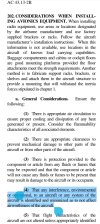
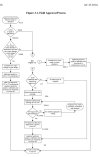
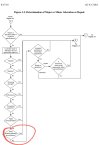
Bell206 is the ultimate decision maker and he does't have to justify that decision to anyone. Maybe he's Michael G. Whitaker?I thought that the FAA is the ultimate authority wrt to determining major vs minor.
Ed Haywood
En-Route
Google "who determines if an alteration is major or minor" and you will find numerous sources stating it is the responsibility of the installer to determine based on the FAR.
AC 43-210a provides additional guidance for aircraft owners, operators, and AMTs:
AC 43-210a provides additional guidance for aircraft owners, operators, and AMTs:
3.2.2 Determine the Repair or Alteration Classification.
Determine if the repair/alteration is a minor change in type design (as defined in 14 CFR part 21, § 21.93) to the product’s type
design; and if so, is it a major or a minor repair/alteration. To determine if a repair/alteration is major or minor, refer to part 43 appendix A. Figure 3-2, Determination of Major or Minor Alteration or Repair, is a flowchart of the field approval evaluation process based on part 43 appendix A.
Last edited:
Dan Thomas
Touchdown! Greaser!
- Joined
- Jun 16, 2008
- Messages
- 11,299
- Display Name
Display name:
Dan Thomas
Another set of numbers: In 2019, there were about 97 million cars and light trucks built worldwide. There were 1100 light airplanes built, worldwide. 88,000:1 in favor of the cars.Avionics are also expensive due to the low volume
In 2022 about 2.86 MILLION cars were sold. In ONE year.
There are about 204,000 GA aircraft in the US. Total.
Dan Thomas
Touchdown! Greaser!
- Joined
- Jun 16, 2008
- Messages
- 11,299
- Display Name
Display name:
Dan Thomas
So, then. Tell us what your aircraft maintenance/modification experience is, including dealing directly with the FAA on certifying modifications.Both AC 43.13-2B and AC 43-210A seem to disagree with you on what you need to consider when making that determination. I doubt you could get away with telling the FAA that you held your thumb at arm's length, closed one eye and went "looks like a minor alteration to me" during an audit.
Bell206 has been at this a very long time, even in retirement. He knows a thousand times as much as you do. Some owners always know so much, unless and until they go to school to get an A&P, and they suddenly don't know much at all.
They are. Just as they are the ultimate authority on what is airworthy or how you perform as an airman. And we see the variances in those topics. However, in the day to day side of things, an A&P makes the determinations on what is minor or major when it comes to alterations and repairs. They even wrote it in the regulations to reflect that responsibility in typical FAA fashion.I thought that the FAA is the ultimate authority wrt to determining major vs minor.
Not at all. When AC 43-210, and by extension Order 8300-16 came out it was a godsend to mechanics as it finally standardized how to determine the minor/major question.Both AC 43.13-2B and AC 43-210A seem to disagree with you on what you need to consider when making that determination.
Personally, I use 43-210 with every minor/major determination to include this one. Makes it simple. So while you got hung up on your highlighted diagram bubble based on your experience level, I simply considered the point and passed through to “NO.”
So maybe you should consider just quitting while you're "ahead?" Trying to learn something as you stated in a previous thread is one thing, but digging yourself into a hole like in this thread doesn't accomplish anything. Your call.
AV8R_87
Line Up and Wait
Trying to learn is a good thing (and not just for me). It's a lot more difficult when you're dealing with people whose only teaching skill is "because I say so".
Installation manual here: https://fccid.io/ANATEL/00008-11-05941/Manual-NPX138/51B942D4-1D07-4E8D-A11A-557BEA5155AA/PDF
Run through whatever guidance material you think is applicable and present your findings.
Then I'll tell you what my decision was almost 20 years ago, and why.
I have no intention of turning this into a manparts waving contest. I have spent a significant amount of time dealing with aircraft certification and finding compliance to the regulations, and I've been audited by the FAA multiple times with no findings or actions coming out of that. When I answered NO (or YES, for that matter) to "other characteristics affecting the airworthiness of the product" I did so in writing, and kept those records. Came in handy during the audits.Tell us what your aircraft maintenance/modification experience is, including dealing directly with the FAA on certifying modifications.
At least I'm not the one that had to resort to insults. How about this, stop the obfuscation and let's have an intelligent conversation on the topic? Since you don't want to present your thought flow for the G3x, here's a simpler scenario: Installation of an FM transceiver into an IFR certified aircraft, with an autopilot capable of flying coupled approaches. The transceiver is mainly used by the cabin crew.Your call.
Installation manual here: https://fccid.io/ANATEL/00008-11-05941/Manual-NPX138/51B942D4-1D07-4E8D-A11A-557BEA5155AA/PDF
Run through whatever guidance material you think is applicable and present your findings.
Then I'll tell you what my decision was almost 20 years ago, and why.
- Joined
- Apr 23, 2013
- Messages
- 6,392
- Display Name
Display name:
3G
Too late, but you doubled down on it with…I have no intention of turning this into a manparts waving contest.
I have spent a significant amount of time dealing with aircraft certification and finding compliance to the regulations, and I've been audited by the FAA multiple times with no findings or actions coming out of that.
Last edited:
- Joined
- Jun 7, 2008
- Messages
- 23,838
- Display Name
Display name:
Bob Noel
I have no intention of turning this into a manparts waving contest.
I think the phrase you were looking for was "Urinary Olympics"
AV8R_87
Line Up and Wait
If you look at what I was replying to, you'll see the information was requested.Too late, but you doubled down on it with
I have learned something new today and I plan on using this in the future. Plus, you made me smile. Thank you.I think the phrase you were looking for was "Urinary Olympics"
But I did. Post 54 and 58. The only thing I didn’t post was how I would have signed off the alteration in the logbook. Would you like me to do that?Since you don't want to present your thought flow for the G3x,
No problem. But before I spend my time again… its your turn to solve a problem since you haven’t responded in kind to any of my requests or questions.here's a simpler scenario: Installation of an FM transceiver into an IFR certified aircraft, with an autopilot capable of flying coupled approaches. The transceiver is mainly used by the cabin crew.
Complete a simple alteration task of my choosing and I’ll reciprocate on the FM radio install with the specific references and include the logbook entry.
Shouldn’t be a problem for someone who has spent a significant amount of time dealing with aircraft certification and finding compliance to the regulations.
Deal?
Insults? Really? You mean like the ones implied below? But yes, let's have an intelligent conversation if you're up for it.At least I'm not the one that had to resort to insults. How about this, stop the obfuscation and let's have an intelligent conversation on the topic?
But hey, I have STCd the iPad for IFR use, right? Next, I'll show you how to make nail soup.
You do have a way of twisting words...
I doubt you're not able to follow the conversation, you're just actively stirring the shpot. What' next, play the stupid game of "Answer yes or no, have you stopped beating your wife?"?
I have no intention of turning this into a manparts waving contest.
Last edited:
AV8R_87
Line Up and Wait
You are the only one that resorted to direct name calling and implied I belonged to a certain group of people... (I don't hold these kinds of views).You mean like the ones implied below?
If you consider the classic children's tale of nail soup an insult, you really need to change your view of life. Same for the others, one of which wasn't even directed at you.
Sure, your justification was "because I think so". I asked for more, and not for the logbook entry, but what convinced you to make that logbook entry.But I did. Post 54 and 58.
You haven't really spent any time providing useful information. I have no expectation that this will change. At this point all you want is to have the last word in the topic, right or wrong.But before I spend my time again…
I have made a statement regarding installing qualified vs unqualified equipment, and justified my decision-making process.
You made claims of how you can install uncertified avionics "easily", despite the lack of qualifications that would allow the installer to prove that the installation does not affect the airworthiness of the aircraft, You haven't been willing to provide an example of an alteration that you performed, with a explanation of how you looked at that specific point of "other qualities affecting airworthiness", besides "I determined the answer to that is NO".
Here's another good example of why, by the time you're done trying to properly install a commercial off the shelf component, the cost will increase significantly. A customer wanted a mission-specific part installed in his IFR aircraft. It had no qualification data available, and the decision was made to have it sent to an RF lab for testing. Good thing it was tested, because it produced a good deal of noise in the ADF band (back then this was still relevant), with a few spikes in the NAV band as well. We had to use twisted shielded power wires and triaxial cable, plus an additional enclosure to contain all that RF noise and get it below the limit. Turned a $2000 box into a $20000 package by the time we were done with it, without the installation costs. RF lab time isn't cheap, especially when you have to go there more than once. Other than that, it was definitely a minor.
Going back to the original thread, a lot of money is spent during design and testing on making sure the equipment will not cause safety issues. Complete failure is less of a problem versus functioning and presenting erroneous information. From that standpoint, that G5 complaining about (and flagging) its heading for apparently no reason (discussed in another thread) is less of an issue than having it happily show that you are 90 degrees off. Complex equipment is in no way perfect, and there's usually a decent-sized list of open problems coming with them, stuff that you might see in real life (and you could be inconvenienced by it) but without a serious safety implication. Your iPad also has a long laundry list of issues, and a bunch of them are quietly fixed behind the scenes and dropped in regular updates. Most of the issues are usually corner cases that users will not encounter in daily operation, so it feels like the device is flawless.
At the end of the day, the goal is simple - we have to do our best to ensure our equipment (and installation) doesn't kill people. And document it properly, so when the pilot flies into the cumulogranite, we can show to the NTSB and the FAA that we did the right things and we weren't the cause of his sudden stop. Even with that, lawyers will still try to eat you alive, but they'll have a much better chance of doing that if your answer to their questions is "I thought it was good".
Val Avionics has a good write-up on installing Non-TSO equipment into certified aircraft.


Installation in type-certificated aircraft
It is widely believed that all avionics equipment that is installed in a type certificated aircraft must have TSO authorization. The purpose of this pamphlet is to examine this idea by references...
www.valavionics.com
Sure, your justification was "because I think so". I asked for more, and not for the logbook entry, but what convinced you to make that logbook entry.
No deal then?You made claims of how you can install uncertified avionics "easily", despite the lack of qualifications that would allow the installer to prove that the installation does not affect the airworthiness of the aircraft,
Regardless, I think your 2nd statement quoted above cuts to the core of your argument.
The way I take it, you are of the opinion that the A&P privileges granted to me under Part 65 and the performance rules I must follow under Part 43 do not “qualify” me to alter an aircraft based on my decision alone.
Maybe you only base this on your experience, don’t know. But in my experience, my A&P gives me a wide range of “qualifications” to make decisions just like this, especially in the Part 91 and Part 135 worlds. But not so much in the Part 121 world as alterations and repairs are required to be part of their mx program.
So to prove my theory, I’ll install a non-certified marine band radio in a Part 91 light single, using the same install summary from my Post 54 above and be as detailed as I can think of to illustrate my point. At the end you will be able to specifically make your argument on where you disagree.
Post 54: “I’d install the equipment”
After unboxing, I’d review the unit physical install and power requirements vs the aircraft. With luck the panel has a spare opening, there is a spare CB of the proper rating, and there is a free spot for the antenna. Prior to install, I would have the audio panel or radio interface box wired up by someone else. So from there, the radio gets bolted in, wires/coax ran and connected, and the antenna mounted.
Post 54: “Perform necessary ground functions”
With the install complete, turn on aircraft power and ensure the radio functions properly by transmitting and receiving on common marine channels and the audio interface/audio panel operates as needed.
Post 54: “Verify any necessary operating parameters”
With the engine running and all the required systems turned on, would verify there is no excessive electrical load and any marine band interference or bleed over with all other installed equipment across the common marine freqs. If there is a parameter I could not check on the ground, I would write up an operational check flight and have it verified in-flight.
Post 54: “sign the book and go fly”
So if everything worked as planned, would make the following entry in the mx record:
“Installed Acme Marine Radio in instrument panel and marine antenna on forward belly. Routed wires/coax and terminated. Radio system function check good. No defects noted. Weight & balance negligible. Reference: AC 43.13-1B & -2B. Determined to be a minor alteration. 2/27/2024; Aircraft TT: 1234:56. Bell206 AP9876543”
Then turn it over to the owner and watch him fly away.
Done. And based solely on my personal decision to install it as a minor alteration with no RF lab or increase in cost. And legal per Part 43.
So how would you install this radio and sign it off?
Ed Haywood
En-Route
IMO that write up has been grossly misused by many. Val came up with a justification specific to their product. People all over the Internet have cited it as proof that TSOs are meaningless and you can toss whatever parts you want into your TC aircraft.Val Avionics has a good write-up on installing Non-TSO equipment into certified aircraft.
AC 20-62E should be required reading for owners and operators of TC aircraft.
AV8R_87
Line Up and Wait
Quick clarification, I was referring to the qualifications of the part, not you as the A&P. Sorry if you thought I was directing that at you.The way I take it, you are of the opinion that the A&P privileges granted to me under Part 65 and the performance rules I must follow under Part 43 do not “qualify” me to alter an aircraft based on my decision alone.
I mostly agree with your approach. The one thing that I did differently, after reviewing the installation manual (specifically the installation approval test procedure) was the EMI test. The manual warned of potential interference with the NAV and COM radios, and gave some examples of what to look for. I had to call the manufacturer of the NAV and COM radios and request information on their intermediate frequency in order to calculate the image frequencies and see if they fell within the operating range of the radio being installed, which they did. I then performed the interference check, which resulted in moderate to severe interference, with the CDI needle deflecting anywhere from half to full scale when the radio was transmitting, but without the flag being displayed. An in-flight interference check showed the problem existed all the way to touchdown, and because the signal was not flagged, the autopilot would not decouple and would continue to follow the erroneous NAV signal.
This was deemed to fall under the "other qualities affecting airworthiness" and the installation to be not approvable in its current form. Since the radio was not under the direct control of the pilot, the only mitigation strategy that he could employ was to pull the circuit breaker as he commenced an instrument approach, which was deemed not acceptable. The solution chosen involved some creative relay logic that would disable the transmit function when the gear was down and the aircraft was airborne, with a placard next to the radio in the cabin indicating that to the operator. Customer was happy with that as well.
Here's the thing, though - I was lucky that NAT was an honest equipment manufacturer that didn't try to hide these potential issues. Other manufacturers of similar equipment never bothered including such information, despite having similar issues or worse. It definitely made me pay a lot more attention and look carefully for these little gotchas. Live and learn.
Some years later the FAA figured it out as well, and sent out letters demanding those check be performed on such radio installs. Sent them a copy of my test results, findings and justification.
Except that wasn’t your position or attitude in your previous posts. So for the benefit of those who are trying to learn from our discussion, perhaps explain what is different now than when you stated... to substantiate a minor alteration determination, you have to demonstrate no appreciable impact on other qualities affecting airworthiness... and that both AC 43.13-2B and AC 43-210A seem to disagree with the approach I followed for which you now mostly agree with?I mostly agree with your approach.
After having spent a few years of my youth in the army stationed in Alaska I also laugh like that when people way they want mil spec camping gear. Haha. I’m like so you want it to be heavy and not keep you warm?I was once shopping for a new radio for my car. The salesman told me that one particular model was "aircraft quality." He didn't understand why I burst out laughing.....
Ron Wanttaja
